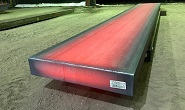Market Data

June 22, 2023
China to Ship ~50,000/MT of Slab to US in June: Commerce Data
Written by Michael Cowden
The US will import approximately ~50,000 metric tons of steel slab from China in June, according to license data from the US Commerce Department.
The figure is notable because the US has imported no significant quantities of Chinese slab in at least the last six years, per Commerce figures. The average price was $694 per metric ton ($630 per short ton), government data indicates.
![]() That’s significantly lower than the average price for Brazilian slabs, which typically account for a significant portion of offshore semi-finished steel imported into the US market. Slabs from Brazil were sold at an average price of $837 per metric ton ($760 per short ton) in June, or 20% more than the prices for Chinese goods, according to Commerce figures.
That’s significantly lower than the average price for Brazilian slabs, which typically account for a significant portion of offshore semi-finished steel imported into the US market. Slabs from Brazil were sold at an average price of $837 per metric ton ($760 per short ton) in June, or 20% more than the prices for Chinese goods, according to Commerce figures.
China sends little finished flat-rolled steel to the United States given prohibitively high anti-dumping and countervailing duties as well as Section 232 and Section 301 tariffs. Slabs are subject to the tariffs but not to the massive AD/CVDs – more than 500% in the case of Chinese cold-rolled, for example.
Unlike Brazil, China is not subject to a Section 232 quota, which Brazil agreed to in exchange for exemption from the 25% tariff.
Market participants said the Chinese tonnage was likely purchased by a re-roller earlier this year amid high US steel prices and limited slab supplies.
Recall that North America faced a brief supply squeeze in the first quarter when Mexican steelmaker AHMSA unexpectedly stopped production. Also, Usiminas, an important Brazilian slab supplier, had taken an extended outage to reline a blast furnace.
A big transaction for Chinese slabs is unlikely to be repeated because US sheet prices have retreated and because more material should become available from traditional sources, some market participants said. They also noted that the Chinese tonnage had created more availability and pressured prices on some of those traditional suppliers.
Others questioned whether Chinese slab shipments to the US might continue given the lack of AD/CVD duties, the large gap between steel prices in the US and those abroad, the absence of Russian semis from the US market over the last year, and slowing economies abroad.
By Michael Cowden, michael@steelmarketupdate.com







